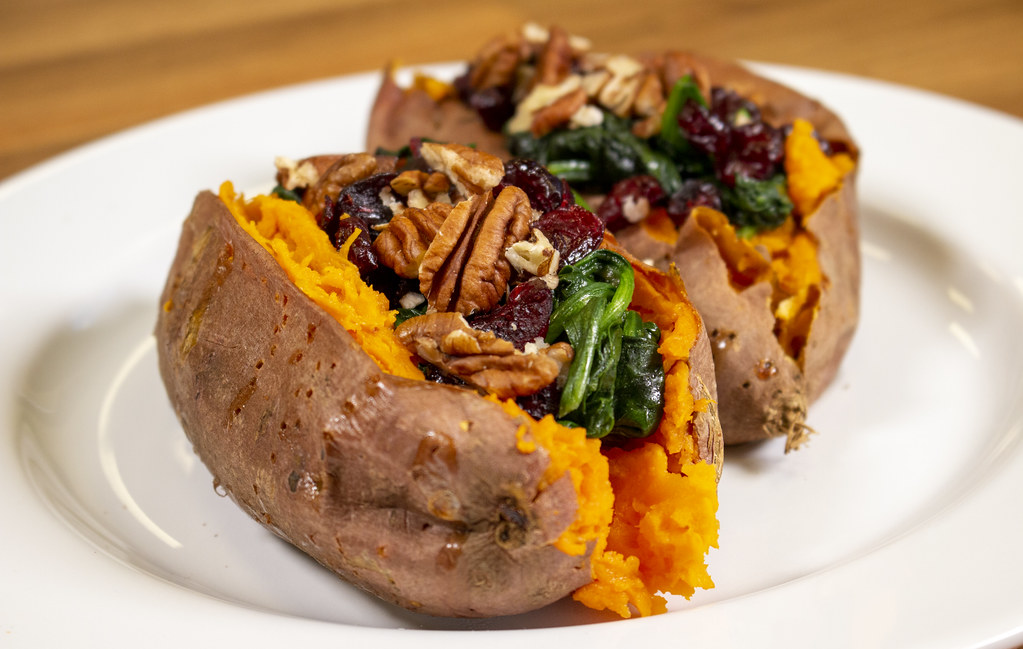Sweet Potato Calories
Introduction
Sweet and regular potatoes are both tuberous root vegetables, but they differ in appearance and taste. They come from different plant families, offer different nutrients and affect blood sugar levels differently. Sweet and regular potatoes are both considered root vegetables but are only distantly belonging to the same family: the sweet potato, also known by the term batata, comes from the Morning glory family, Convolvulaceae, and white potatoes are nightshades or Solanaceae. The edible part of these plants are the tubers that grow on the roots.
Both varieties originated in regions of Central and South America, but are now grown and consumed around the world. Sweet potatoes typically have brown skin and orange flesh, but are also available in purple, yellow, and red varieties. Regular potatoes come in shades of brown, yellow, and red and have white, yellow, or purple flesh.
Normal and sweet potatoes: nutritional values
Sweet potatoes are often thought of as healthier than white
potatoes, but in fact, both types can be highly nutritious. Here is a
nutritional comparison of 100 grams of white and sweet potato, including skin.
White potato |
Sweet potato |
|
Calories 92 |
90 |
|
Protein 2 grams |
2 grams |
|
Fat 0.15 grams |
0.15 grams |
|
Carbohydrates 21 grams |
21 grams |
|
Fiber 2.1 grams |
3.3 grams |
|
Vitamin A 0.1%of the daily value(DV) |
107% |
|
Vitamin B6 12% |
17% |
|
Vitamin C 14% |
22% |
|
Potassium 17% |
10% |
|
Calcium 1% |
3% |
|
Magnesium 6% |
6% |
Potatoes: varieties in comparison
While regular and sweet potatoes are comparable in calories, protein and carbohydrate content, white potatoes provide more potassium, while sweet potatoes are quite rich in vitamin A. Both types of potatoes also contain other beneficial plant compounds. . Sweet potatoes are packed with antioxidants that help fight cell damage in the body caused by free radicals. Regular potatoes contain compounds called glycoalkaloids, which have been shown to have anticancer effects.
Glycemic index of the different types of potatoes
Different types of potatoes also differ in their glycemic index (GI), a measure of how a particular food affects blood sugar. Foods with a GI of 70 or higher cause a faster rise in blood sugar than foods with an average GI of 56-69 or a low GI of 55 or lower.
Depending on the type and cooking process, sweet potatoes can have a GI of 44-94. Baked sweet potatoes tend to have a much higher GI than boiled sweet potatoes due to how the starches gel during cooking. The GI of regular potatoes also varies. For example, boiled red potatoes have a GI of 89 while baked potatoes have a GI of 111.
People who have diabetes or other problems related to insulin resistance, or metabolic-type syndromes, may benefit from restricting high-glycemic foods. Therefore, nutrition experts recommend choosing sweet potatoes over white potatoes, as the sweet variety generally has a lower GI.
However, how potato consumption affects blood sugar largely depends on the type of potato, portion size, and cooking method. While some sweet potato varieties may have a lower GI than regular potatoes, others don't.
How to cook potatoes healthily
Although potatoes are highly nutritious, they are often prepared in unhealthy ways such as: fried, mashed with butter and cream, or baked and topped with high-calorie ingredients.
To prepare sweet or regular potatoes in a healthy way, healthier cooking methods such as boiling or baking are recommended. Maintaining the skin allows you to have a greater supply of fibers. Serve with fresh herbs or spices instead of cheese, butter and salt. Pairing potatoes with foods that have fewer carbohydrates, such as lean protein and non-starchy vegetables, can also limit their effect on blood sugar. The combination with cereals is the most insidious in terms of raising blood sugars. One of the cereals that best contributes to the balance of the glycemic index is buckwheat. Avoid rice.
The sweet potato is halfway between the pumpkin and the potato, therefore, its use in the kitchen is versatile. It lends itself to the preparation of numerous recipes, it can also be eaten raw and in this case its flavor is reminiscent of carrots. It can also be used for the preparation of desserts. However, some precautions are necessary: the sweet potato is much more tender than the traditional potato and its cooking takes place in a much shorter time. The red batata can also replace the pumpkin, in the preparation of risottos and sauces, fillings and cakes, and the carrot, condita raw in mixed salads or cooked in soups and broths.

Post a Comment